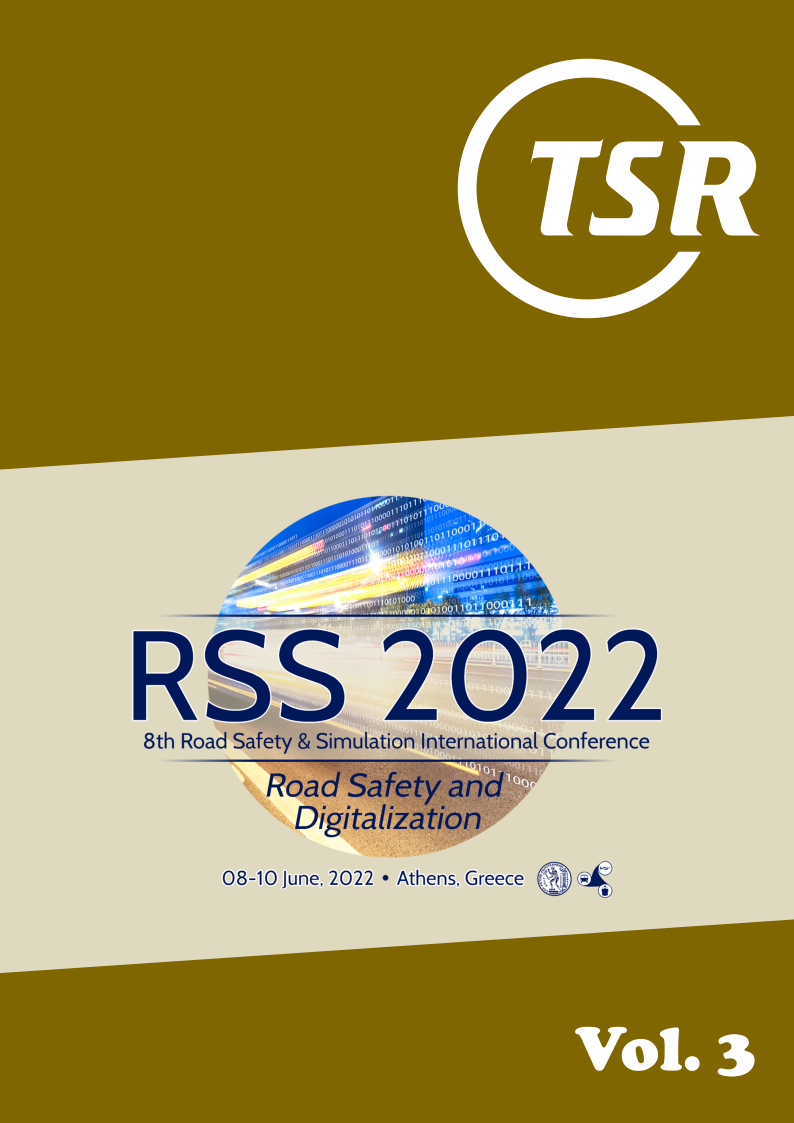Identification of evasive manoeuvres in traffic interactions and conflicts
DOI:
https://doi.org/10.55329/erqd8683Keywords:
collision course, evasive action, evasive manoeuvre, motion prediction, near-misses, Surrogate Measures of Safety (SMoS), Time-to-Accident (TA), Time-to-Collision (TTC), traffic conflictsAbstract
The study presents a simple and easy to implement method for detection of the evasive action start in traffic interactions. The method is based on comparison of the studied trajectory with a reference set of ‘unhindered’ trajectories, interpreting the start of evasive action as the moment when no more similarities can be found. The suggested algorithm performs well for primary interactions when road users arrive in an unhindered state. It fails, however, in case of secondary interactions. Explorative application of the method on a large dataset of normal and conflict traffic situations concludes that traffic conflicts occur more frequently in secondary interactions, presumably due to higher cognitive load on the involved road users. Despite the limitations, the method can be used both for the safety studies based on traffic conflicts and for more general quantification and visualisation of the road user behaviour.
Downloads
References
Allen, B. L., B. T. Shin, P. J. Cooper (1978), ‘Analysis of traffic conflicts and collisions’, Transportation Research Record: Journal of the Transportation Research Board, 667, 67–74, https://onlinepubs.trb.org/Onlinepubs/trr/1978/667/667-009.pdf.
Bagdadi, O. (2013), ‘Assessing safety critical braking events in naturalistic driving studies’, Transportation Research Part F: Traffic Psychology and Behaviour, 16, 117–126. DOI: https://doi.org/10.1016/j.trf.2012.08.006
Chang, A., N. Saunier, A. Laureshyn (2017), ‘Proactive methods for road safety analysis. White paper’ (SAE International), Technical Paper WP-0005, https://www.sae.org/publications/technical-papers/content/wp-0005. DOI: https://doi.org/10.4271/WP-0005
Fisher, R. A. (1932), Statistical methods for research workers (Edinburgh: Oliver & Boyd).
Gettman, D., L. Pu, T. Sayed, S. Shelby (2008), ‘Surrogate Safety Assessment Model and Validation’ (McLean, Virginia: U. S. Department of Transportation, Federal Highway Administration), FHWA-HRT-08-051, https://www.fhwa.dot.gov/publications/research/safety/08051/08051.pdf.
Grayson, G. B. (1984), ‘The Malmö study: a calibration of traffic conflict techniques’ (SWOV), R-84-12, https://www.ictct.net/wp-content/uploads/SMoS_Library/LIB_Grayson_1984.pdf.
Güttinger, V. A. (1982), ‘From Accidents to Conflicts: Alternative Safety Measurement’, presented at Third International Workshop on Traffic Conflicts Techniques (Leidschendam, The Netherlands), https://www.ictct.net/wp-content/uploads/XX-Leidschendam-1982/Guttinger_1982.pdf.
Hayward, J. C. (1972), ‘Near-miss determination through use of a scale of danger’, Highway Research Record, 384, 24–35, https://onlinepubs.trb.org/Onlinepubs/hrr/1972/384/384-004.pdf.
van der Horst, A. R. A. (1990), ‘A time-based analysis of road user behaviour in normal and critical encounters’, PhD thesis, Delft University of Technology.
Hydén, C. (1977), ‘A Traffic-Conflicts Technique for Examining Urban Intersection Problems’, presented at First Workshop on Traffic Conflicts (Oslo, Norway: 26-27 September 1977), https://www.ictct.net/wp-content/uploads/XX-Oslo-1977/1977-Hyden.pdf.
Hydén, C. (1987), ‘The development of a method for traffic safety evaluation: the Swedish traffic conflict technique’, PhD, Lund University, Department of Traffic Planning and Engineering, Bulletin 70, https://www.ictct.net/wp-content/uploads/SMoS_Library/LIB_Hyden_1987.pdf.
InDeV (2015-2018), ‘InDeV: In-depth Understanding of Accident Causation for Vulnerable Road Users’ (EU Horison 2020, Framework Programme for Research and Innovation, project No. 635895), https://www.bast.de/InDeV/EN/Home/home_node.html.
Johnsson, C., A. Laureshyn, T. De Ceunynck (2018), ‘In search of surrogate safety indicators for vulnerable road users, a review of surrogate safety indicators’, Transport Reviews, 38 (6), 765–785. DOI: https://doi.org/10.1080/01441647.2018.1442888
Johnsson, C., A. Laureshyn, C. D'Agostino, T. De Ceunynck (2020), ‘The ‘safety in density’ effect for cyclists and motor vehicles in Scandinavia: An observational study’, IATSS Research. DOI: https://doi.org/10.1016/j.iatssr.2020.08.003
Koo, T. K., M. Y. Li (2016), ‘A Guideline of Selecting and Reporting Intraclass Correlation Coefficients for Reliability Research’, Journal of Chiropractic Medicine, 15 (2), 155–163. DOI: https://doi.org/10.1016/j.jcm.2016.02.012
Kruysse, H. W. (1991), ‘The subjective evaluation of traffic conflicts based on an internal concept of dangerousness’, Accident Analysis & Prevention, 23 (1), 53–65. DOI: https://doi.org/10.1016/0001-4575(91)90035-4
Kruysse, H. W., G. J. Wijlhuizen (1992), ‘Why are experts not better in judging the danger of filmed traffic conflicts?’, Accident Analysis & Prevention, 26 (3), 227–235. DOI: https://doi.org/10.1016/0001-4575(92)90002-Z
Laureshyn, A., C. Johnsson, T. De Ceunynck, et al. (2016), ‘Review of current study methods for VRU safety. Appendix 6 – Scoping review: surrogate measures of safety in site-based road traffic observations’ (InDeV, Horizon 2020 project), Deliverable 2.1 – part 4, https://www.ictct.net/wp-content/uploads/SMoS_Library/LIB_Laureshyn_et_al_2016.pdf.
Laureshyn, A., M. de Goede, N. Saunier, A. Fyhri (2017), ‘Cross-comparison of three surrogate safety methods to diagnose cyclist safety problems at intersections in Norway’, Accident Analysis & Prevention, 105, 10–20. DOI: https://doi.org/10.1016/j.aap.2016.04.035
Laureshyn, A., A. Varhelyi (2020), ‘The Swedish Traffic Conflict Technique: Observer’s manual’ (Lund, Sweden: Technology & Society, Faculty of Engineering, LTH, Lund University), https://www.ictct.net/wp-content/uploads/SMoS_Library/LIB_Laureshyn_Varhelyi_2020.pdf.
Lefèvre, S., D. Vasquez, C. Laugier (2014), ‘A survey on motion prediction and risk assessment for intelligent vehicles’, ROBOMECH Journal, 1 (1). DOI: https://doi.org/10.1186/s40648-014-0001-z
Lightburn, A., C. I. Howarth (1979), ‘A study of observer variability and reliability in the detection and grading of traffic conflicts’, presented at Second international traffic conflicts technique workshop (Paris, France: 10-12 May), https://www.ictct.net/wp-content/uploads/XX-Paris-1979/1979-Lightburn-Howarth.pdf.
Madsen, T. (2018), ‘Video analysis and mapping of vulnerable road users' safety’, PhD, Aalborg University, Denmark.
MathWorks (2022), ‘Matlab, product family’ (The MathWorks, Inc.), https://www.mathworks.com.
Migletz, D. J., W. D. Glauz, K. M. Bauer (1985), ‘Relationships between traffic conflicts and accidents’ (U.S. Department of Transportation, Federal Highway Administration), FHWA/RD-84/042, https://www.ictct.net/wp-content/uploads/SMoS_Library/LIB_Migletz_et_al_1985.pdf.
Mohamed, M. G., N. Saunier (2013), ‘Motion Prediction Methods for Surrogate Safety Analysis’, Transportation Research Record: Journal of the Transportation Research Board, 2386, 168–178. DOI: https://doi.org/10.3141/2386-19
Pasanen, E. (1993), ‘The video recording of traffic accidents’ (Helsinki, Finland: Helsinki City Planning Department), 1993:4.
Saunier, N., T. Sayed, K. Ismail (2010), ‘Large scale automated analysis of vehicle interactions and collisions’, Transportation Research Record: Journal of the Transportation Research Board, 2147, 42–50. DOI: https://doi.org/10.3141/2147-06
Saunier, N., A. Laureshyn (2021), ‘Surrogate Measures of Safety’, in Vickerman, R. (ed.) International Encyclopedia of Transportation (Oxford: Elsevier), 662–667. DOI: https://doi.org/10.1016/B978-0-08-102671-7.10197-6
St-Aubin, P., N. Saunier, L. F. Miranda-Moreno (2014), ‘Road user collision prediction using motion patterns applied to surrogate safety analysis’, presented at 93rd TRB Annual Meeting (Washington DC, USA: 12-16 January 2014).
Svensson, Å. (1992), ‘Vidareutveckling och validering av den svenska konflikttekniken’ [Further development and validation of the Swedish traffic conflict technique] (Lund, Sweden: Traffic Planning & Engineering, Institute of Technology, Lund University), https://www.ictct.net/wp-content/uploads/SMoS_Library/LIB_Svensson_1992.pdf.
T-Analyst (2020), ‘Software for semi-automated video processing’ (Technology & Society, Faculty of Engineering, LTH, Lund University), https://bitbucket.org/TrafficAndRoads/tanalyst/wiki/Manual.
Tageldin, A., T. Sayed (2016), ‘Developing evasive action-based indicators for identifying pedestrian conflicts in less organized traffic environments’, Journal of Advanced Transportation, 50, 1193–1208. DOI: https://doi.org/10.1002/atr.1397
Tarko, A., G. Davis, N. Saunier, et al. (2009), ‘Surrogate measures of safety’ (TRB Subcommittee on Surrogate Measures of Safety ANB20(3)), White paper, https://www.ictct.net/wp-content/uploads/SMoS_Library/LIB_Tarko_et_al_2009.pdf.
af Wåhlberg, A. E. (2004), ‘The stability of driver acceleration behavior, and a replication of its relation to bus accidents’, Accident Analysis & Prevention, 36 (1), 83–92. DOI: https://doi.org/10.1016/S0001-4575(02)00130-6
Yastremska-Kravchenko, O., A. Laureshyn, C. D'Agostino, A. Varhelyi (2022), ‘What constitutes traffic event severity in terms of human danger perception?’, Transportation Research Part F: Traffic Psychology and Behaviour, 90, 22–34. DOI: https://doi.org/10.1016/j.trf.2022.08.001
Downloads
Published
How to Cite
Issue
Section
Categories
License
Copyright (c) 2022 Carl Johnsson, Aliaksei Laureshyn

This work is licensed under a Creative Commons Attribution 4.0 International License.









